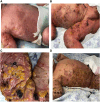A case report of neonatal incontinentia pigmenti complicated by severe cerebrovascular lesions in one of the male monozygotic twins
- PMID: 38832002
- PMCID: PMC11144854
- DOI: 10.3389/fped.2024.1338054
A case report of neonatal incontinentia pigmenti complicated by severe cerebrovascular lesions in one of the male monozygotic twins
Abstract
Background: This article reports a case of neonatal incontinentia pigmenti onset in only one male monozygotic twin with characteristic skin lesions after birth followed by severe cerebrovascular lesions.
Case presentation: A male infant, the first of monozygotic twins, was born with multiple yellow pustules all over his body, repeated new herpes at different sites during the course of the disease, aggravated by fusion, warty crusts, and hyperpigmentation; biopsy pathology suggested eosinophilic spongiform edema of the skin. Peripheral blood eosinophils were significantly elevated, and brain magnetic resonance imaging revealed diffuse multiple cystic and lamellar abnormal signal areas in the left frontal and parietal lobes. On day 30, the infant showed neurological symptoms, such as poor response and apnea, and an emergency cranial computed tomography scan revealed abnormal changes in the left cerebral hemisphere and bilateral cerebellum. After admission, he was given a potassium permanganate bath and topical mupirocin for 1 month, and the skin abnormalities improved. He was treated with mechanical ventilation and vasoactive drugs for 2 days after the cerebrovascular accident, and died the same day after the parents chose hospice care. No deletion variants or point mutations were detected in subsequent genetic tests, and chromosomal copy number variation tests revealed different degrees of chimeric duplications and deletions in different regions of chromosomes Y and 3. The parents were healthy, and his twin brother had normal growth and development with no abnormalities at multiple follow-up visits.
Conclusion: Neonatal incontinentia pigmenti in only one male monozygotic twin is extremely rare and the genetic diagnosis is challenging. Awareness of the combined cerebrovascular lesions needs to be enhanced, and potential prevention and treatment methods need to be explored to improve the prognosis.
Keywords: IKBKG gene; cerebrovascular lesions; incontinentia pigmenti; monozygotic twins; neonatal.
© 2024 Lin, Zhang and Zhou.
Conflict of interest statement
The authors declare that the research was conducted in the absence of any commercial or financial relationships that could be construed as a potential conflict of interest.
Figures




References
-
- Orphanet Report Series. Prevalence and incidence of rare diseases: bibliographic data. Rare Diseases Collection. (2017) 1:1–73.
Publication types
LinkOut - more resources
Full Text Sources
Miscellaneous

